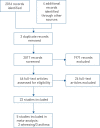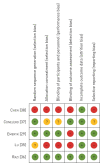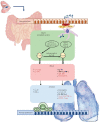Bacterial lysate therapy for the prevention of wheezing episodes and asthma exacerbations: a systematic review and meta-analysis
- PMID: 33246991
- PMCID: PMC9488706
- DOI: 10.1183/16000617.0175-2019
Bacterial lysate therapy for the prevention of wheezing episodes and asthma exacerbations: a systematic review and meta-analysis
Abstract
Wheezing and asthma are a growing cause of morbidity in children and adults. Treatment is aimed at prevention of disease exacerbations and preservation of lung function. Respiratory viruses are involved in ∼40-60% of exacerbations. Bacterial lysates prevent recurrent respiratory tract infections and might reduce exacerbations. Moreover, immunomodulatory effects have been observed in human and animal studies. Here we aimed to assess the effects of bacterial lysate therapy on preschool wheezing episodes and asthma exacerbation frequency. We performed a systematic literature review based on the Preferred Reporting Items for Systematic reviews and Meta-Analysis (PRISMA) statement and a meta-analysis using Cochrane Review Manager. Out of 2016 retrieved articles, 22 studies were included, of which five provided sufficient data for a meta-analysis.The use of bacterial lysates showed a decrease of both wheezing episodes (mean difference -2.35 (-3.03- -1.67), p<0.001) and asthma exacerbations in children (mean difference -0.90 (-1.23- -0.57), p<0.001). Additionally, antibiotic use was reduced, and the duration of wheezing episodes was also decreased. No data for adults with asthma are currently available. The immunomodulatory effect seems to be dependent on increased T-helper (Th)1-cell activation and Th2-cell suppression.These favourable effects of bacterial lysates indicate that they show promise as add-on therapy in preschool wheezing and childhood asthma.
Copyright ©ERS 2020.
Conflict of interest statement
Conflict of interest: G.M. de Boer has nothing to disclose. Conflict of interest: J. Żółkiewicz has nothing to disclose. Conflict of interest: K. Strzelec has nothing to disclose. Conflict of interest: M. Ruszczyński has nothing to disclose. Conflict of interest: R.W. Hendriks has nothing to disclose. Conflict of interest: G.J. Braunstahl has nothing to disclose. Conflict of interest: W. Feleszko reports speaker honoraria from Vifor Pharma. Conflict of interest: G.A. Tramper-Stranders reports grants from European Society for Pediatric Infectious Diseases, Stichting Coolsingel, and a grant, personal fees and non-financial support from OM-Pharma for an affiliated project during the conduct of the study. All fees were paid to the research foundation.
Figures




